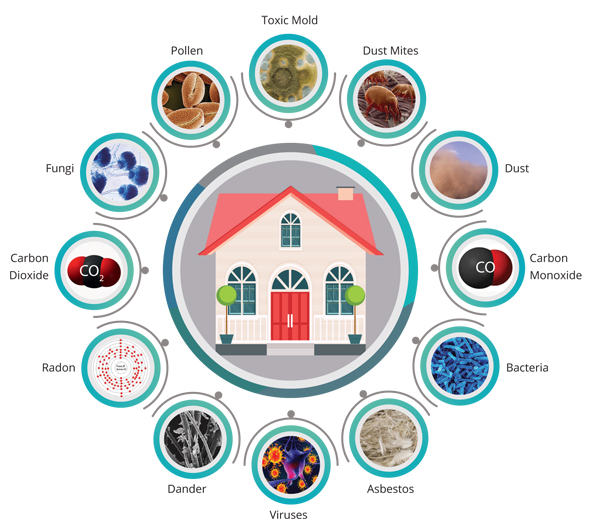 You probably know that it’s harmful to breathe in polluted air when you’re outside. The same is true when you’re indoors. We spend about 90% of our time indoors – at home, at work, at school, or when we go to shops or restaurants. Air pollution, both indoors and out, is the largest environmental risk to public health. It produces both short term and long-term illness and potentially reduces life expectancy.
You probably know that it’s harmful to breathe in polluted air when you’re outside. The same is true when you’re indoors. We spend about 90% of our time indoors – at home, at work, at school, or when we go to shops or restaurants. Air pollution, both indoors and out, is the largest environmental risk to public health. It produces both short term and long-term illness and potentially reduces life expectancy.
Architects, designers, employers, building owners and governments worldwide are responding to a large amount of evidence that the work environment has a profound effect on health and well-being.
What is Health and Well-Being?
Well-being is the experience of health, happiness, and prosperity. It includes having good mental health, high life satisfaction, a sense of meaning or purpose, and ability to manage stress. It’s a subjective measure of how comfortable we are in our present situation and with our life in general. The broad definition of health includes well-being, but in this context refers to diseases and conditions that make us physically unwell, such as infections, allergies, tiredness, headaches, and respiratory, skin or vision problems.

Causes of Poor Indoor Air Quality
Air quality is a measure of how clean or polluted the air is. It is determined by the environmental conditions and the amount of particles and polluting gases that it contains. These can be biological and non- biological and natural or human in origin. Industrial countries have a large number of products for use in businesses that emit volatile chemicals and particles into the air and are present in every indoor environment.
Common sources of contaminants in indoor air include the following:
Biological contamination from humans and animals:
Human-derived microbes, for example, from sneezing and coughing; droppings and detritus from birds, rodents and cockroaches.
Biological contamination:
Fungi and bacteria caused by condensation and damp materials, dust mites and pollen from outdoor air.
Volatile organic compounds (VOCs) from building components:
Plywood and fiberboard, insulation materials, vinyl and plastic wall and floor coverings, carpets and upholstered furniture, adhesives
VOCs, Ozone (O3) and particles from industrial and household products:
Paints, solvents, waxes and polishes, air fresheners, drain cleaners, printers and copiers, perfumes, soaps, writing and drawing materials, paper products, cooked food, tobacco and vaping products.
Biological contamination and VOCs from HVAC systems:
Contaminated liners and filters, dirty drain pans, lubricants, refrigerants, leaking boilers and furnaces.
Traffic and industrial pollutants from outdoors:
Particles from vehicle exhausts and factories, and gaseous pollutants such as nitrous oxide (NO2), carbon monoxide (CO), sulfur dioxide (SO2).
Radon:
This radioactive gas occurs naturally in rocks and seeps through the ground into buildings where it can accumulate and increase the risk of lung cancer.
Indoor heating and cooling sources, the outdoor environmental conditions, the amount of sunlight and the design of the building and the HVAC system (heating, ventilation and air conditioning) can all affect indoor climate.

How Poor Indoor Air Quality Affects Health
Poor air quality causes a wide range of negative effects on the people in a building, including medical symptoms, reduced feeling of well-being and drop in performance in work and learning environments. The effect of any pollutant depends on multiple factors, including concentration of the pollutant, duration of exposure, age, gender, sensitivity and health of the people exposed. Here are the impacts of some of the typical indoor pollutants:
1.Carbon Monoxide (CO):
It is an odorless, colorless and toxic gas. Because it is impossible to see, taste or smell the toxic fumes, CO can kill you before you are aware it is in your home. CO can cause fatigue, impaired vision at lower concentrations and headache, dizziness, nausea and death at higher concentrations.
2.Particulate Matter:
Particulate matter (also referred to as PM or particle pollution) is a complex mixture of solid and/or liquid particles suspended in air. Effects of PM include respiratory illnesses, including asthma and bronchitis in the short term and heart disease and lung disease in the long term, and also anxiety and hypertensive disorders.
3.Biological Pollutants:
Biological contaminants include bacteria, viruses, animal dander and cat saliva, house dust, mites, cockroaches, and pollen. Biological contaminants trigger allergic reactions and some types of asthma and can also cause infectious illnesses, such as influenza, measles and chicken pox are transmitted through the air.
4.Nitrogen Dioxide (NO2):
Nitrogen dioxide, or NO2, is a gaseous air pollutant composed of nitrogen and oxygen and is one of a group of related gases called nitrogen oxides. It causes a range of harmful effects on the lungs, including, inflammation of the airways, increased asthma attacks and reduced lung function.
5.Volatile organic compounds (VOCs):
VOCs are emitted as gases from certain solids or liquids. VOCs include a variety of chemicals, some of which may have short- and long-term adverse health effects. Health effects include, eye, nose, throat irritation, headaches, nausea and damage to liver, kidney and central nervous system.
6.Radon:
Radon is a dense, colorless, odorless noble gas that occurs naturally in the soil as the product of the radioactive decay of radium; it is a decay product of uranium and thorium, which occur naturally in the Earth’s crust. When you breathe in radon, radioactive particles from radon gas can get trapped in your lungs. Over time, these radioactive particles increase the risk of lung cancer. It may take years before health problems appear.

How to improve air quality
These pollutants can be kept to a minimum, first by using good practices in building design and maintenance to control emissions from building materials. The majority of buildings, however, were built before the modern standards were developed so they are still potential sources of the air pollutants described earlier. HVAC systems can clean the air to some extent, but this will vary depending on age and maintenance frequency.
There are also portable devices that can be placed in rooms to process the air and remove pollutants. These air purifiers suck air through multi-layer filters that capture airborne particles such as pollen, bacteria, viruses and fungal spores, and absorb VOCs using active carbon. Air purifiers are an efficient way to improve the air quality in a room.
Plants are nature’s natural air filters. Buying a few indoor plants can do wonders to improve the indoor air quality in your home or office, while enhancing your décor and ambiance. But not all houseplants are created equal, here are some plants that improve air quality and filter toxins, Bamboo Palm, English Ivy, Gerbera Daisy, Red Edged Dracaena, Warneckii Dracaena, Spider Plant.

Natural Environments and Well-Being
Even short-term exposure to green is sufficient to unfold salutogenic effects. In a classical study, Ulrich (1984) studied the recovery records of surgical patients in a suburban Pennsylvania hospital between 1972 and 1981. Some of the patients were – purely by chance – allocated to a room with a view of a natural setting, others to a room with a view of a brick wall. Patients facing a natural setting had shorter post-operative hospital stays, received fewer negative comments in nurses’ notes, and requested less medication. In a follow-up experiment, Ulrich et al. (1991) had 120 subjects first view a stressful film and then exposed them to videos of different natural and urban settings, measuring their self-reported affective and physiological states. The authors find that stress recovery was faster and more complete when subjects were exposed to natural rather than urban settings. Mechanisms include a shift towards a more positively-toned emotional state, positive changes in physiological activity levels, and that these changes are accompanied by sustained attention.
Natural environments may have indirect positive impacts by encouraging certain behaviors, for example, physical exercise or social interaction, through the provision of public, open space, which improves mental or physical health and longevity, and thereby happiness.



